What to Feed Arowana Fish?: Did you know that an Arowana in the wild can leap up to 6 feet out of the water to catch prey? Such a remarkable feat underscores the importance of providing proper nutrition to these majestic fish in captivity. Feeding Arowana fish, particularly when transitioning from live feeder fish to pellets and mammal fillets, can be challenging yet essential for their health and growth.
This comprehensive Arowana feeding guide is designed to help fish enthusiasts successfully balance the carnivorous preferences of Arowanas with their nutritional necessities. By understanding the variegated dietary needs of these piscatorial pets, owners can ensure their Arowanas thrive, exhibit vibrant health, and grow to their full potential.
Table of Contents
Feed Arowana Fish : Key Takeaways
- Transitioning Arowana from live feeder fish to pellets requires patience and methodical introduction.
- Ensuring a balanced diet is crucial for the health and growth of Arowana fish.
- Proteins are vital in an Arowana diet, reflecting their natural carnivorous instincts.
- Live feeder fish come with health risks, making alternative food sources safer options.
- Adapting the Arowana diet as they grow helps cater to their changing nutritional needs.
Understanding Arowana Dietary Needs
Feeding Arowanas requires meticulous consideration due to their unique nutritional needs and natural dietary habits. Understanding these factors is essential for any enthusiast committed to optimizing their Arowana’s health and longevity.
Nutritional Requirements
Arowanas, being carnivorous fish, necessitate a diet rich in proteins to meet their nutrient requirements. This ensures their robust growth and vibrant health. The ideal Arowana diet should be diversified to include various protein sources, maintaining a balanced intake that aligns with the heightened demand for Tropical Fish Nutrition.
Natural Diet of Arowanas
In their natural habitat, Arowanas are surface feeders, utilizing their barbels to detect movements on the water surface. These predatory fish consume a range of prey including insects, small fish, and occasionally birds. Replicating this natural diet as closely as possible is vital in captivity to meet their intrinsic nutrient requirements and to foster a dietary environment that reflects their evolutionary preferences.
The Importance of a Balanced Diet for Arowanas
Ensuring a Balanced Arowana Diet is crucial for the overall Arowana Health. A diet that includes varied nutritious components aids in their vibrant physical appearance and robust health. Let’s explore why a balanced diet is vital for these majestic fish.
Health Benefits
A balanced diet contributes significantly to the metabolic functions and general well-being of Arowanas. Nutrient-rich food options support their immune system, enhance coloration, and optimize growth rates. Moreover, maintaining a wholesome diet helps in preventing common health issues, ensuring longevity and sustained vigor.
Avoiding Nutritional Deficiencies
To Prevent Nutritional Deficiencies and promote Arowana Health, it is essential to incorporate diverse food sources. An unbalanced diet may lead to health complications such as weakened immune responses, stunted growth, and diminished vitality. Thus, maintaining a diet inclusive of all necessary nutrients is integral for their continued health and longevity.
| Diet Component | Importance | Sources |
|---|---|---|
| Proteins | Essential for growth and tissue repair | Live feeder fish, insects, high-protein pellets |
| Vitamins & Minerals | Boost immune system and metabolic processes | Supplemental pellets, fresh greens, commercial vitamin additives |
| Fats | Provide energy and support cell structure | Fish oils, fatty fish like salmon |
| Carbohydrates | Offer energy, though required in minimal amounts | Processed pellets, formulated for fish with limited carb needs |
Feeding Arowana Fish
When it comes to feeding Arowana fish, understanding the diverse options available can significantly impact their health and growth. The following approaches are widely adopted by enthusiasts to strike a balance between mimicking natural feeding habits and ensuring safety against disease transmission.
Live Feeder Fish
Live feeder fish are often used to cater to the predatory instincts of Arowanas. This method aligns closely with their natural hunting behaviors observed in the wild. While providing live feeder fish, such as guppies or small goldfish, ensures engagement and exercise, it is critical to be cautious about potential disease transmission. Quarantining feeder fish before introducing them to the tank can mitigate some risks, but exploring safer alternatives is advisable.
Frozen Fish Foods
Frozen fish foods offer a safer and equally nutritious option. Varieties such as mysis shrimp and silversides are ideal frozen choices that can provide essential proteins and fats necessary for the growth and vitality of Arowana fish. The process of freezing kills most pathogens, reducing the risk of disease. Additionally, the convenience of storage and preparation makes frozen fish foods a practical choice for many aquarium hobbyists.
Pellets and Dry Foods
Introducing Arowana pellets and dry foods into their diet can enhance nutritional balance and ease feeding routines. These foods are specifically formulated to meet the dietary needs of carnivorous fish like Arowanas. High-quality Arowana pellets rich in proteins, vitamins, and minerals promote healthy growth and a robust immune system. Incorporating a variety of feeding methods ensures a holistic approach to the Arowana’s diet, making pellets an invaluable addition.
| Feeding Method | Benefits | Considerations |
|---|---|---|
| Live Feeder Fish | Mimics natural hunting behavior, provides exercise | Risk of disease, requires quarantine |
| Frozen Fish Foods | Safe from pathogens, nutritious, convenient storage | Requires freezing and preparation |
| Arowana Pellets and Dry Foods | Balanced nutrition, easy to feed, promotes health | Needs gradual introduction |
Introducing New Foods to Your Arowana
The process of Arowana Diet Adaptation can be both rewarding and challenging as it requires patience and a strategic approach. Transitioning your Arowana from live feeder fish to New Foods for Arowana like pellets and mammal fillets means observing and responding to their unique Arowana Appetite cues. Starting with gradual introductions and mixing new foods with their regular diet can help in overcoming initial reluctance.
Monitoring your Arowana’s feeding behavior and adjusting based on their response ensures a smoother adaptation. Initially, offering small amounts of the new foods alongside familiar ones helps in gauging their acceptance levels. Persistence without forcing sudden changes plays a crucial role in seamless integration of these new dietary components.
- Start by mixing a small portion of new food with their favorite live feeder fish.
- Gradually increase the proportion of the new food over time.
- Observe the Arowana Appetite and adjust the quantities accordingly.
- Ensure the new diet offers balanced nutrition to meet Arowana Diet Adaptation needs.
Consistency is key as you strive to achieve a diversified diet, enhancing your Arowana’s overall health and reducing dependence on live feeder options.
Arowana Pellets: Choosing the Right Type
Choosing the optimal Arowana pellets is essential for ensuring a well-rounded diet that meets the unique nutritional needs of these majestic fish. Different types of pellets can support various aspects of their health and vitality, especially focusing on their protein demands and overall nutritional balance. Below, we explore the main types of pellets to consider.
High-Protein Pellets
A high-protein diet is crucial for Arowana, given their carnivorous nature. High-Protein Pellets cater directly to this requirement, providing essential amino acids that support muscle growth, health, and activity levels. These pellets also mimic the nutritional profile of their natural prey, making them an excellent staple in an Arowana’s diet.
Supplemental Pellets
In addition to high-protein options, Nutritional Pellets for Arowana are available to ensure a balanced diet. These supplemental pellets often contain vitamins, minerals, and other nutrients that contribute to the fish’s overall well-being. They can also help in enhancing the vibrant coloration and physiological functions, thus promoting a healthier and more robust fish.
When creating a diet plan for your Arowana, it’s beneficial to consider both Arowana Pellets and supplemental options. This balanced approach ensures that all nutritional bases are covered, providing a comprehensive dietary regimen that promotes longevity and vitality.
| Pellet Type | Main Benefits | Usage Frequency |
|---|---|---|
| High-Protein Pellets | Supports Growth and Muscle Development | Daily |
| Supplemental Pellets | Enhances Overall Health, Coloration, and Vitality | 2-3 times per week |
Feeding Schedule and Portion Control
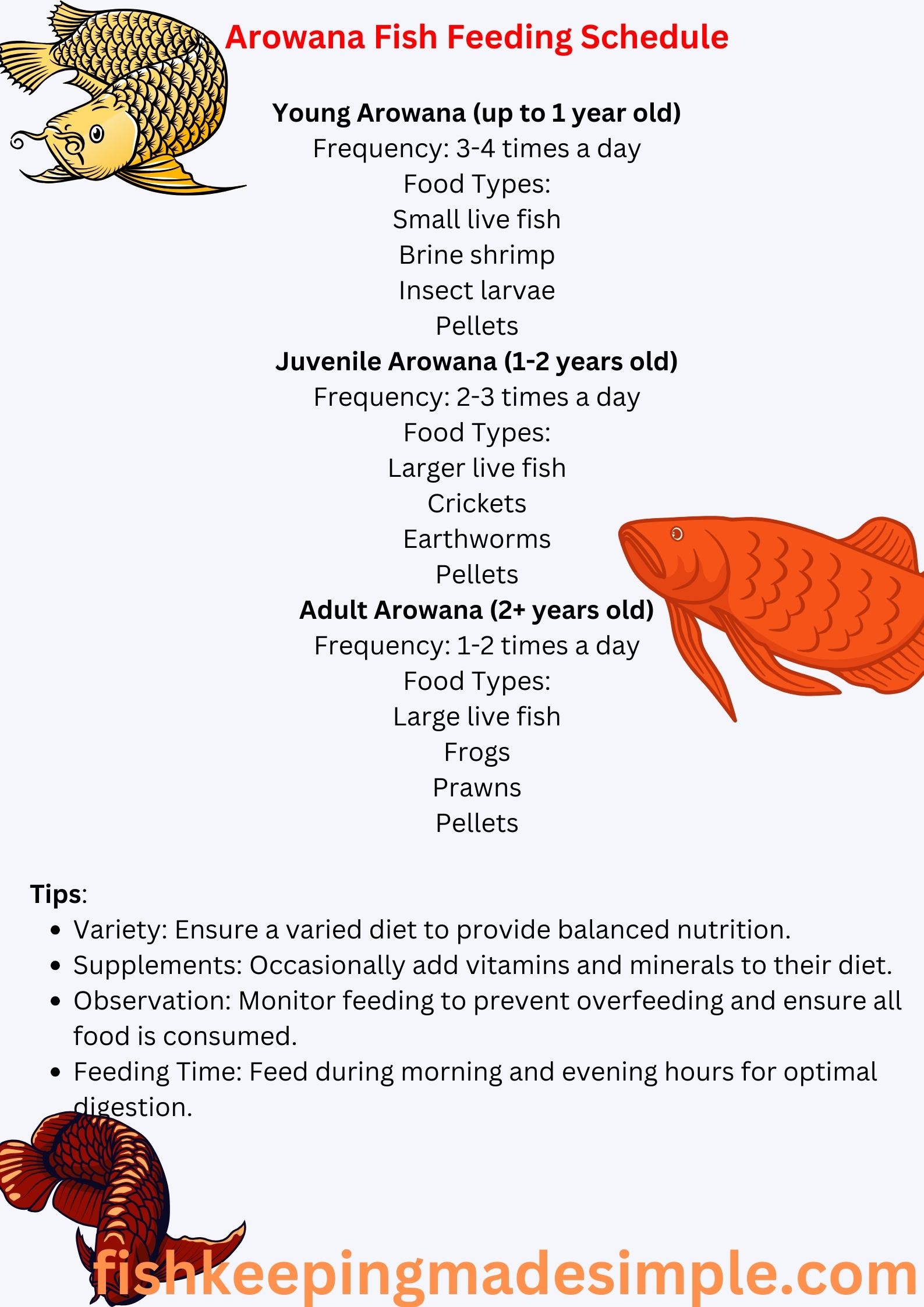
Establishing an effective Arowana Feeding Schedule is essential for the health and longevity of your fish. Maintaining a balanced Portion Control regimen prevents obesity and other associated health issues. It’s crucial to understand the natural Arowana Feeding Habits to foster a suitable feeding routine.
Feeding frequency varies with the life stages of Arowanas. Juvenile Arowanas require feeding more frequently compared to adults. Typically, young Arowanas should be fed twice a day, while adults can be fed once every two days. Monitoring and adjusting the portions based on their growth patterns and activity levels is necessary to avoid overfeeding. Below, I have outlined a recommended feeding schedule:
- Juvenile Arowanas: Feed twice daily with a portion size that is manageable within 2-3 minutes.
- Adult Arowanas: Feed once every two days with a portion size consumed within 3-5 minutes.
Aiming to replicate the natural diet and feeding habits can help in establishing a perfect balance, contributing to the fish’s overall well-being. Adhering to these guidelines will ensure that the feeding regimen remains optimal without overwhelming the fish’s metabolic processes or compromising the water quality in their habitat.
Signs of Overfeeding and How to Avoid It?
Overfeeding Arowanas can lead to several health problems and disturb the balance of their aquarium environment. Recognizing the symptoms and adopting appropriate feeding strategies are crucial steps in preventing these issues.
Recognizing Overfeeding
The signs of overfeeding Arowanas are often visible through various indicators. One of the most apparent signs is leftover food in the aquarium, which decays and deteriorates water quality. Additionally, you may notice increased waste production from your fish, signaling that they are consuming more than their digestive systems can handle.
Changes in water quality, such as cloudy water or excess algae growth, are also critical indicators. Overfeeding can cause physiological problems in Arowanas, such as fatty liver disease, which can significantly impact their longevity and vitality.
Proper Portion Sizes
To avoid the pitfalls of overfeeding Arowanas, determining the proper Arowana portion size is imperative. Arowanas have varying dietary requirements depending on their age, size, and activity levels. Younger Arowanas generally require more frequent feedings with smaller portions to support their rapid growth, while adult Arowanas benefit from larger, less frequent meals.
Here is a helpful guideline for determining the proper portion sizes based on the type of food and the age of the Arowana:
| Age | Type of Food | Portion Size | Feeding Frequency |
|---|---|---|---|
| Juvenile | Pellets | Small amounts | 2-3 times daily |
| Adult | Frozen Fish Foods | Larger pieces | Once per day |
| Senior | Supplemental Pellets | Moderated | Every other day |
Adjusting portion sizes and feeding frequencies based on the specific needs of your Arowana helps prevent overfeeding and ensures they receive balanced nutrition.
Adjusting the Diet as Your Arowana Grows
Understanding the necessity of diet adjustments for Arowana is crucial as they progress from juveniles to mature adults. This transformation requires a keen observation of their changing nutritional needs and energy requirements to ensure optimal Arowana growth.
Initially, young Arowanas thrive on a protein-rich diet, making live feeder fish and small insects beneficial for their rapid growth phases. As they mature, incorporating a variety of food becomes essential. This mix could include pellets, frozen fish foods, and mammal fillets. Diverse Arowana dietary changes cater to evolving dietary needs and prevent monotony, ensuring each meal is balanced and nutrient-rich.
Here’s a concise overview of suitable diet changes at different growth stages:
| Growth Stage | Dietary Focus | Recommended Foods |
|---|---|---|
| Juvenile | High Protein | Live Feeder Fish, Insects |
| Sub-Adult | Balanced Nutrition | Frozen Fish Foods, High-Protein Pellets |
| Adult | Diet Diversity | Pellets, Mammal Fillets, Mixed Frozen Foods |
Regularly reassessing and adapting the diet to the current life stage not only supports their Arowana growth but also fortifies their health, vitality, and overall well-being. Emphasizing appropriate diet adjustments for Arowana at each stage ensures they receive the nutrients necessary for a robust and thriving existence.
Conclusion
Understanding the intricacies of Arowana nutrition is critical for ensuring these majestic fish live healthy and fulfilling lives. Throughout this feeding guide, we’ve explored the specific dietary needs of Arowanas, from their natural predatory instincts to the importance of introducing a balanced diet in captivity. As Arowana owners, it is essential to adapt their feeding habits to include high-protein pellets, safe frozen fish foods, and even occasional feeder fish, while avoiding the pitfalls of overfeeding and nutritional deficiencies.
This comprehensive Arowana Nutrition Summary aims to arm you with actionable insights for sustaining the health, vitality, and vibrant appearance of your aquatic pet. By focusing on each life stage, recognizing signs of overfeeding, and alluding to the importance of portion control, we can ensure our Arowanas thrive. Transitioning from live food to more reliable and nutrient-rich alternatives can seem daunting, but it is a pivotal step toward fostering an environment where your Arowana can flourish.
In summary, the emphasis on tailored Arowana Diet Guidelines ensures a holistic approach to feeding practices, which, in turn, enhances the longevity and well-being of these fascinating fish. Utilizing the insights provided in this Feeding Arowana Fish Recap, you are now better equipped to nurture your Arowana, making it a stunning centerpiece of your aquarium collection. Keeping abreast of the evolving needs as your Arowana grows will undoubtedly reflect in its health and beauty, rewarding your commitment to its care.
FAQ
What should I feed my Arowana to ensure it gets a balanced diet?
What are the essential nutrient requirements for Arowanas?
How often should I feed my Arowana fish?
Can I feed live feeder fish to my Arowana?
How do I transition my Arowana to pellets and mammal fillets?
What should I look for when choosing Arowana pellets?
How can I prevent overfeeding my Arowana?
What are the signs that my Arowana is overfed?
How should I adjust my Arowana’s diet as it grows?
Are frozen fish foods a good alternative to live feeder fish?
How important is it to provide a variety in the Arowana’s diet?
References
Ornamental Aquatic Trade Association (OATA)
Convention on International Trade in Endangered Species of Wild Fauna and Flora (CITES)
I am a passionate aquarist with over 30 years of hands-on experience in fishkeeping. My journey began at a young age, collecting fish from the wild and learning through experimentation. Specializing in tropical fish, I bring a deep understanding of the hobby to FishKeepingMadeSimple. The site provides honest, detailed reviews of essential products and accessories to help fellow enthusiasts create the best environments for their fish.


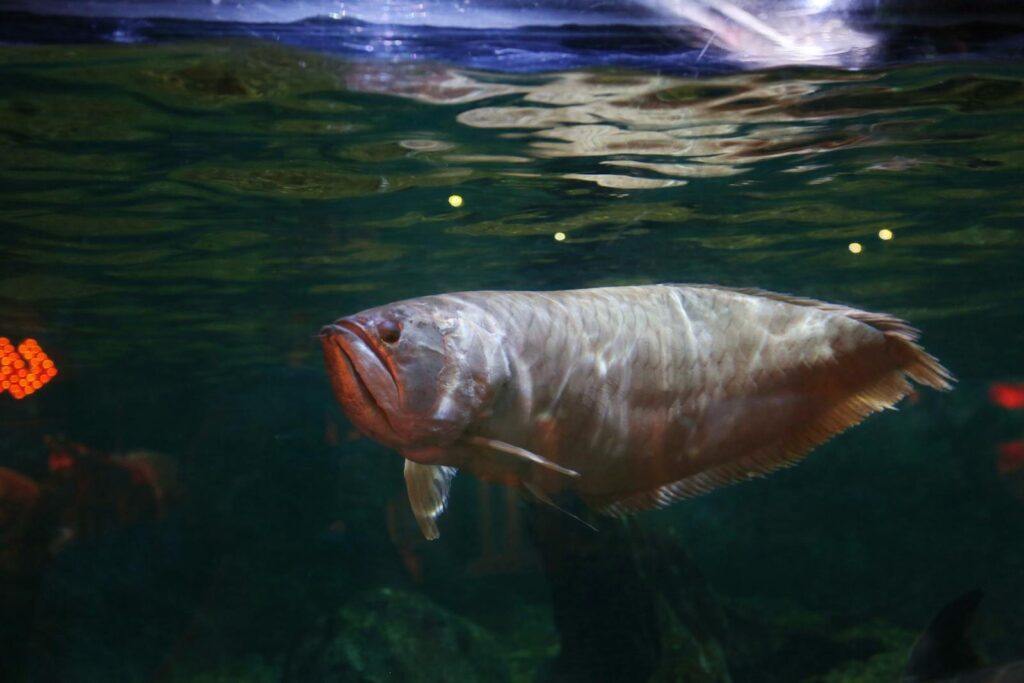
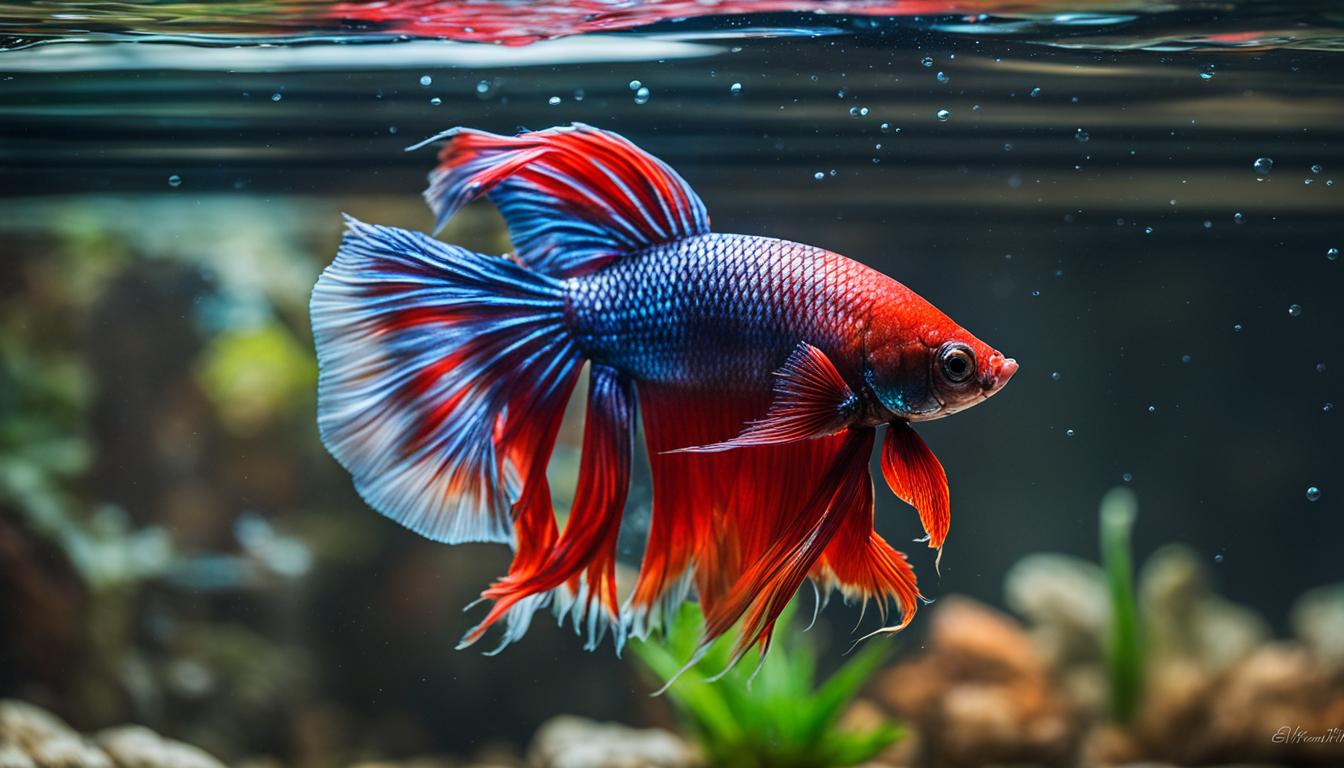
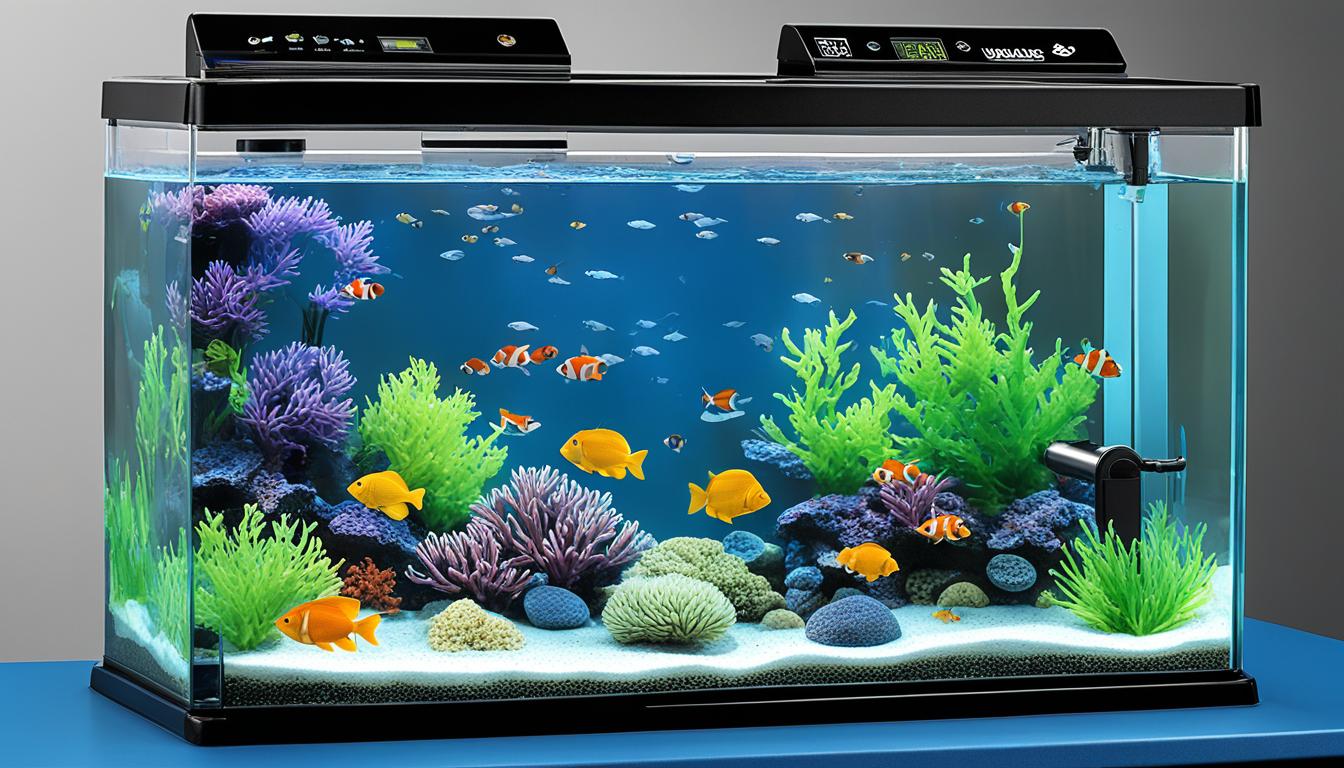

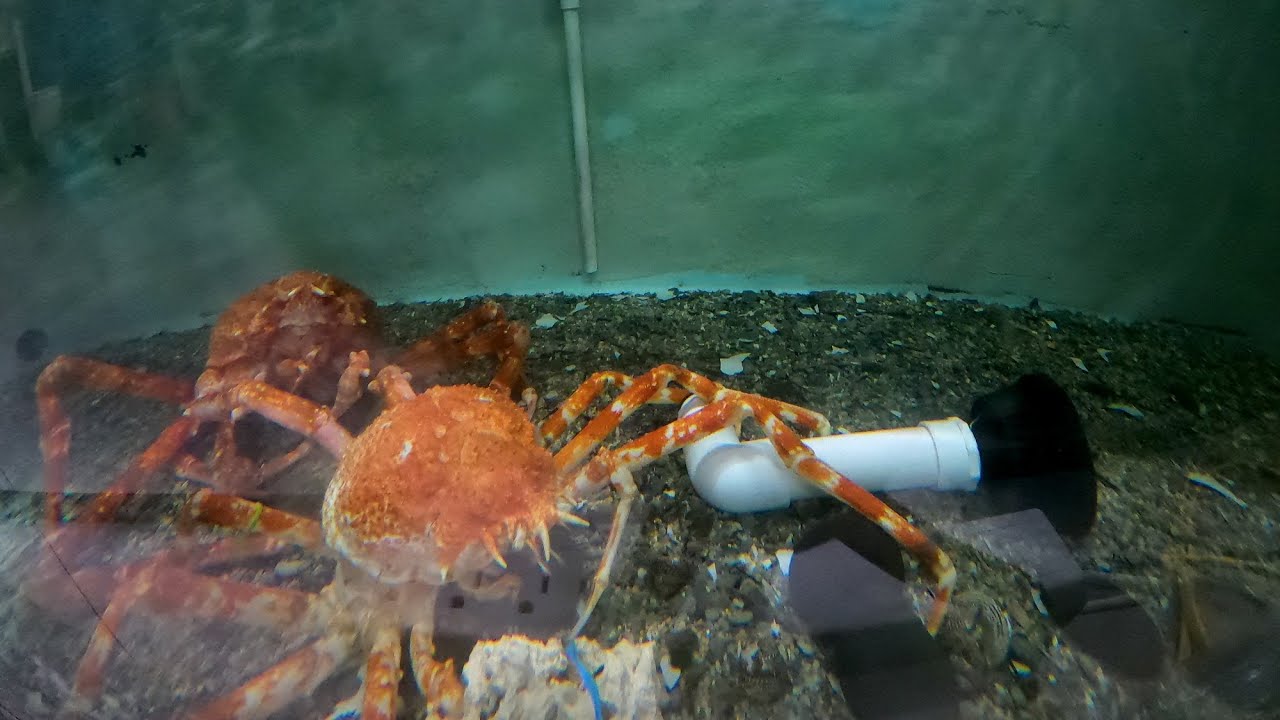
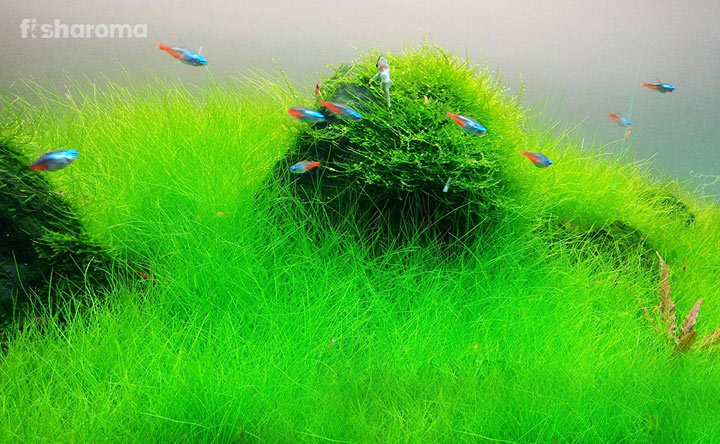
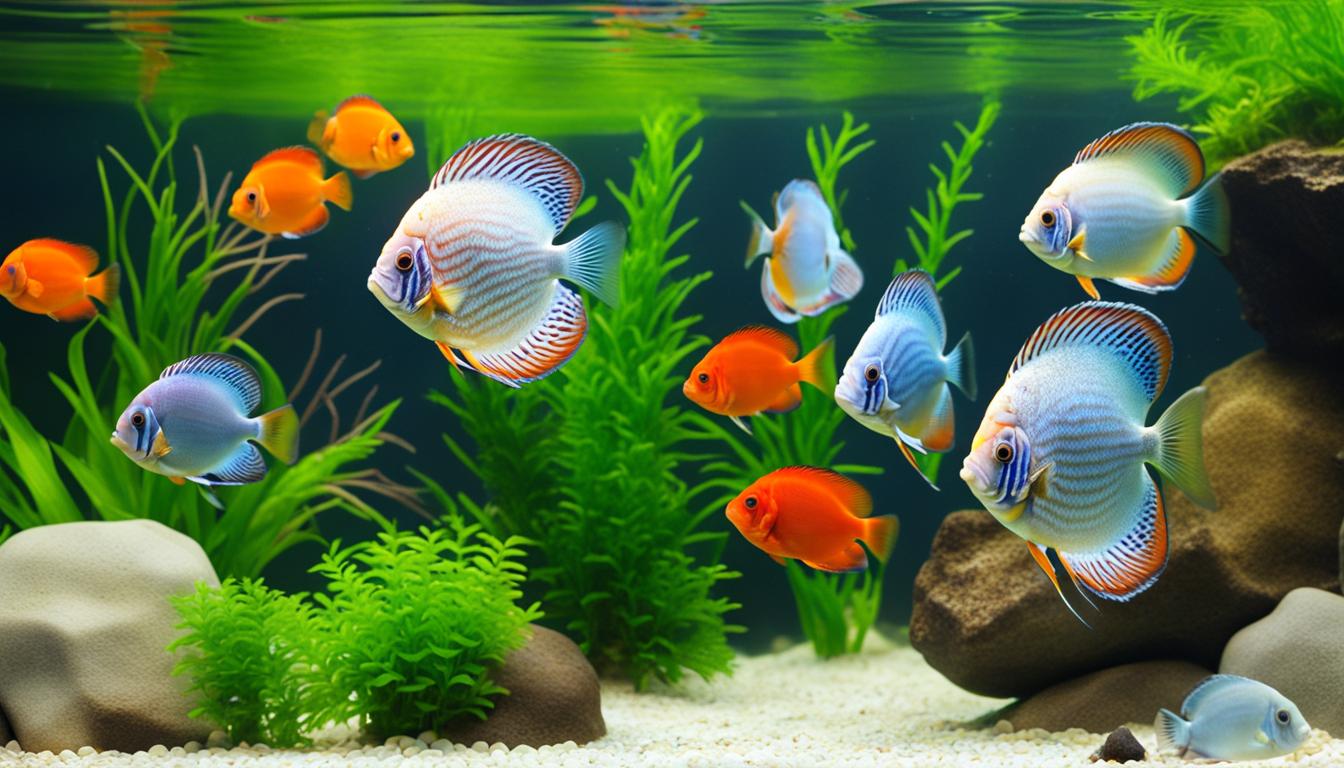
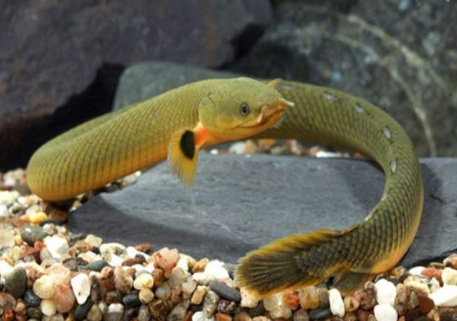
[…] Arowana fish are celebrated for their prehistoric lineage and cultural significance, often symbolizing prosperity and good fortune. This makes them highly coveted among dedicated aquarists. However, Arowana fish care is not for beginners. With large tank requirements, specific water parameters, and a carnivorous diet, these fish present a rewarding challenge for the experienced hobbyist. Potential caretakers must diligently monitor water quality, diet, and overall tank maintenance to nurture and sustain these fascinating fish, which can live for over two decades with proper care. […]
[…] and conducting regular health checks. Each of these elements plays a critical role in preventing Arowana Nutritional Deficiencies and reducing Arowana Environmental Stress. Let’s delve into each of these […]
[…] rams eat both meat and veggies. Their diet should include high-quality pellets, live or frozen foods, and some greens. This mix will keep them healthy and show off their […]
[…] the water clean is a must for a smooth breeding cycle. Feeding triggers their desire to spawn. A diet with live or frozen foods, like brine shrimp and bloodworms, works well. High-quality, protein foods are essential for their […]
[…] live and frozen foods offers many benefits over flakes. They’re more nutritious, improve coloration, and encourage […]